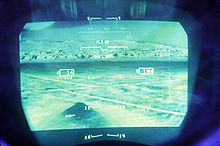LANTIRN
The LANTIRN system (short for L ow A ltitude N avigation and T arge ting I nfra R ed for N ight ) is an infrared-controlled navigation and target system for low-level flight operations at night. It enables the pilots of F-15 and F-16 combat aircraft to operate at night and in any weather. The LANTIRN system was developed by Martin Marietta for the US Air Force in the 1980s and shipped from March 1987.
construction
The LANTIRN system consists of a navigation container and a target container, which are mounted externally on the machine. With the included terrain contour flight radar and a fixed infrared sensor , the aircraft can operate under all visibility and weather conditions.
The AN / AAQ-13 navigation canister gives the machine the ability to quickly penetrate enemy airspace and make precision attacks on tactical targets at night and in adverse weather conditions. The navigation container contains a terrain following radar and a rigidly built-in infrared detector, which feeds optical information into the flight control system of the aircraft, which is thereby able to maintain a certain height above ground and avoid obstacles. This sensor shows an infrared image of the terrain in front of the aircraft on the pilot's head-up display . This enables the pilot to manually follow the contour of the terrain and use mountains, valleys and the darkness to remain undetected. The vessel was the first forward looking infrared navigation system for fighter aircraft of the USAF . The export version of the AN / AAQ-13 is called AN / AAQ-19 "Pathfinder". It usually lacks the AN / AAQ-13's terrain tracking radar.
Target container
The AN / AAQ-14 target container contains a forward-looking infrared sensor ( FLIR ) that provides the pilot with an infrared image of the target, a laser / laser range finder for the precise dropping of bombs, a correlator that the viewfinder of the AGM-65 Mavericks on aligns the target point of the container and software for automatic target tracking. These devices simplify the tasks of discovering, recognizing and attacking targets and also allow pilots of single-seater jets to attack ground targets with precision weapons on their first overflight. The export version of the AN / AAQ-14 is called the AN / AAQ-20 "Sharpshooter" with less equipment. It lacks the above-mentioned correlator for the AGM-65 Maverick. There is also the LANTIRN ER target container with improved systems.
history
The development of LANTIRN began in September 1980 at Martin Marietta, now part of Lockheed Martin , in Orlando , Florida . The first operational tests and trials of the navigation capsule were successfully completed in December 1984. In March 1985, the Air Force initially placed an order for production in small numbers, and from November 1986 series production was carried out on a large scale. The first mass-produced capsule was delivered to the Air Force on March 31, 1987. LANTIRN represented a major step forward in the US military's ability to conduct operations in darkness and poor weather conditions. In 1994 the US Navy began looking for a short-term replacement for a long-range attack aircraft after the A-6 Intruder had been retired. It was decided to integrate the LANTIRN targeting system into the F-14 Tomcat to give the aircraft the ability to perform precision attacks.
Users
-
 Egypt : approx. 100 containers, including 65 used target containers from the USA
Egypt : approx. 100 containers, including 65 used target containers from the USA -
 Bahrain : 3 Sharpshooter tanks
Bahrain : 3 Sharpshooter tanks -
 Belgium
Belgium
-
 Denmark : 13 LANTIRN target containers, 3 LANTIRN ER target containers
Denmark : 13 LANTIRN target containers, 3 LANTIRN ER target containers -
 Greece
Greece
-
 Israel
Israel
-
 Netherlands
Netherlands
-
 Norway
Norway
-
 Portugal
Portugal
-
 Saudi Arabia : 48 pairs of containers
Saudi Arabia : 48 pairs of containers -
 Singapore
Singapore
-
 South Korea
South Korea
-
 Taiwan : 28 pairs of containers
Taiwan : 28 pairs of containers -
 Turkey
Turkey
-
 United States
United States
swell
- US Air Force LANTIRN SYSTEM

